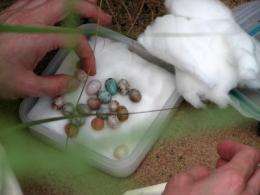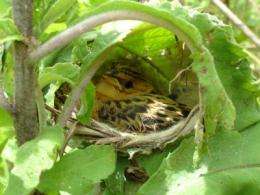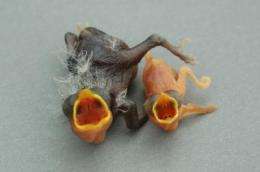Scientists get bird's-eye view of how cuckoos fool their hosts (w/ Video)

Using field experiments in Africa and a new computer model that gives them a bird's eye view of the world, Cambridge scientists have discovered how a bird decides whether or not a cuckoo has laid an egg in its nest. The finding offers unique insights into a 20 million-year-old evolutionary arms race.
Only seven groups of birds in the world have evolved as brood parasites, laying their eggs in other birds' nests, and ecologists have long been fascinated by this behaviour as an example of evolution in action.
Dr Claire Spottiswoode and Dr Martin Stevens of the University of Cambridge worked on two tropical African species, the parasitic Cuckoo Finch and one of its hosts, the Tawny-flanked Prinia.
Until recently, most work on cuckoos has been done in temperate regions - Europe and North America - where species are relatively young in evolutionary terms. In the tropics, however, the Cuckoo Finch and Prinia could have been locked together in an evolutionary arms race for up to 20 million years.
As parasites have evolved ever better manipulation of their hosts, hosts have responded with ever more refined defences to evade parasitism. As a result, the Cuckoo Finch's mimicry of host eggs is extraordinary, as is the Prinias' ability to spot the parasite's eggs.

According to Dr Spottiswoode: "Prinias lay probably the most diverse range of eggs of any bird in the world, and this is likely to be an outcome of the long co-evolutionary battle with the Cuckoo Finch."
"The eggs are analogous to a bank note, in terms of the variety and complexity of markings, perhaps to make them very hard to forge by the parasite."
To find out exactly how Prinias detect the foreign eggs, Spottiswoode and Stevens set up more than 100 rejection experiments in southern Zambia, putting one Prinia egg into another's nest and waiting to see if the egg was rejected.
They also collected data to feed into a computer model to give them a bird's eye view of the world, using a spectrophotometer to measure egg colours and a digital camera to analyse the eggs' complex patterns.
In the past, this kind of analysis was tackled by humans comparing eggs by eye, but human vision differs hugely from that of a bird. Birds can see ultraviolet light and because they have four types of cone in their eyes, compared with three in humans, they see a greater diversity of colour and pattern.

Spottiswoode and Stevens found that Prinias are amazingly good at rejecting foreign eggs, and that they use colour and several aspects of pattern to spot the parasite's eggs. Mysteriously, however, they do not seem to use the scribbles that uniquely occur only on the Prinias' eggs.
The specific traits used to distinguish foreign eggs were exactly those found to differ most between host eggs and real parasitic eggs. This suggests that natural selection is currently acting to make Cuckoo Finch eggs better mimics of their hosts', and also that Prinias use the most reliable information available in making rejection decisions.
The work is published in PNAS on Monday 26 April 2010.
Provided by University of Cambridge















